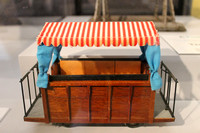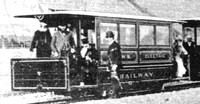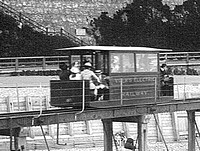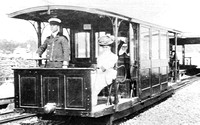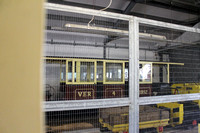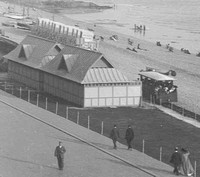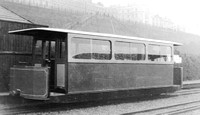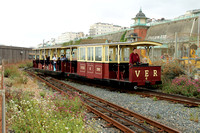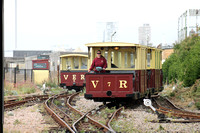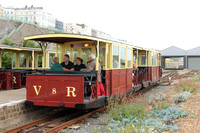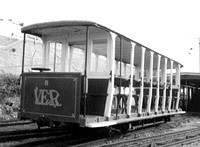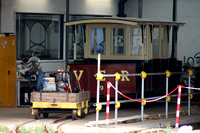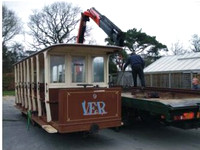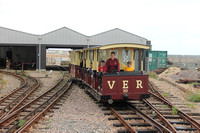Volks Electric Railway 25.7.22
I visited the Volks Electric Railway for the very first time on Monday 25th July. This short 1 mile line has many years of interesting history and is the oldest remaining electric railway in the world.
I will describe my visit later in the blog but first some of the history of the line:
The Founder
Magnus Volk, the son of a German Clockmaker was born in Brighton on 19th October 1851, he was known as an inventor and pioneer in the Brighton area with some of his projects including inventing a fire alarm system, having the first electrically lit house in Brighton, an early attempt at telecommunications with a neighbouring house and having a contract to electrically light Brighton's Royal Pavilion.
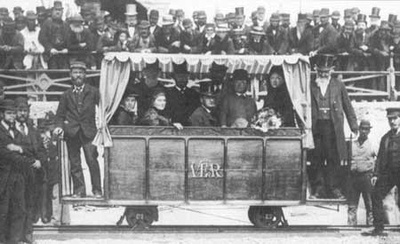
 Demonstration Line
Demonstration Line
His successful experimentations with electricity led to his next, most successful and enduring project: the Volk's Electric Railway! After gaining permission from Brighton Corporation for a 1/4 mile long 2 foot gauge line running from the Palace Pier to the Chain Pier, work quickly progressed and before long, the line was ready! The line was powered by a 2 horse power gas engine, which drove a Siemens D5 50 volt DC Generator. The original car, built by William Pollard in 1883, seated 10 passengers and resembled a coal wagon with drivers platforms, awning over the passenger area as well as curtains for the side. The 1 1/2 horse power motor allowed for a top speed of 6 mph. Magnus Volk unveiled this creation to a very interested public at 12 noon on 6th August 1883.
Early years
With the initial line being a success, Volk applied for permission to extend the line Westwards to the town boundary, unfortunately permission wasn't granted, however he did get permission to extend the line eastwards to the Banjo Groyne and rented out the 'Arch' at Paston Place, which was to become the VER Headquarters (remains so to this day) and the line's workshops. A line was built across the promenade to reach the Arch Workshops, which also housed the line's new upgraded power generator.
Over winter 1883/84 the line was relayed to the wider gauge of 2 ft 8 1/2 inches and the new stretch required some structures to be built in the form of timber trestles to bridge the gaps in the shingle and the section at the Chain Pier made on a gradient to allow the line to pass underneath the pier Initally the track was of the 2 rail variety with one rail being the live feed and the other was the return, however this proved unreliable especially in stormy conditions and the system was switched to run off the third rail in 1886. A 2 platform station was opened at the Banjo Groyne with a halt opening halfway along the line, where a passing loop was also built. Palace Pier station was also a 2 platform station. The line now had a total length of 1400 yards.
The original Pollard built car was unable to be converted to the new wider gauge so it was scrapped and replaced by two new cars (numbered 1 & 2). The new cars had a central passenger saloon with seating for 18 passengers on long bench seats with 12 passengers able to be seated outside on the open platforms. Similar to most trams of the time, the passenger saloon was accessed from the centre of the open platforms, which also featured the driver's controls.
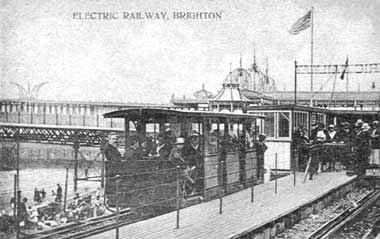
 The new extended line opened on 4th April 1884 and only Car 1 was in use at this time as Car 2 did not arrive till Summer 1885. With the installation of the 3rd rail in 1886, the line was also raised and placed onto a wooden viaduct. With the arrival of Car 2, the service level was increased to a car every 5 minutes. The line grew in popularity with it more cars with bigger capacity were required so in 1892, Cars 3 and 4 were built by the VER and initially entered service as open sided cars seating 40 people, however it was soon realised that the cars were unsuitable for winter operation as their canvas blinds were of no real use against the harsh winter weather and they were converted to semi-open trams that winter, with a further refurbishment in 1901 bringing them to the same shape / style that they are in today. A further car was built in 1896, car 5, which was built by the VER to a similar style as that of car 2, seating 30 passengers but with one difference, the window panes were detatchable, making suitable as a summer and a winter car where required.
The new extended line opened on 4th April 1884 and only Car 1 was in use at this time as Car 2 did not arrive till Summer 1885. With the installation of the 3rd rail in 1886, the line was also raised and placed onto a wooden viaduct. With the arrival of Car 2, the service level was increased to a car every 5 minutes. The line grew in popularity with it more cars with bigger capacity were required so in 1892, Cars 3 and 4 were built by the VER and initially entered service as open sided cars seating 40 people, however it was soon realised that the cars were unsuitable for winter operation as their canvas blinds were of no real use against the harsh winter weather and they were converted to semi-open trams that winter, with a further refurbishment in 1901 bringing them to the same shape / style that they are in today. A further car was built in 1896, car 5, which was built by the VER to a similar style as that of car 2, seating 30 passengers but with one difference, the window panes were detatchable, making suitable as a summer and a winter car where required.
The Daddy Long Legs
Magnus Volks wanted to extend the line eastwards towards Rottingdean, however a steep climb to the cliff top or the possibility of building a viaduct over unstable ground ruled this out, so ever being the inventor, he came up with an ingenious invention, 'The Daddy Long Legs'. The Daddy Long Legs was basically a cross between a tram and a boat with large legs reaching the seabed where rails were installed! There was an overhead wire installed with trolley pole giving the tram element. The rails were laid from Paston Place to Rottingdean through the water but reasonably close to the shore. Opening in 1896, the Daddy Long Legs proved popular, however the experiment almost ended in disaster as a massive storm shortly after opening caused serious damage including the vehicle ending up on its side. Volks percivered and repairs were completed, allowing the line to reopen in 1897.
Things wouldn't run smoothly for long as damage to the trackbed closed the line for 2 months in 1900, followed by the news that the line would have to be diverted deeper into the sea to make room for new sea defences between Paston Place and Black Rock essentially ended this unique railway, however the end of the Daddy Long Legs had good effects on the future of the Volks Electric Railway .....
Extension
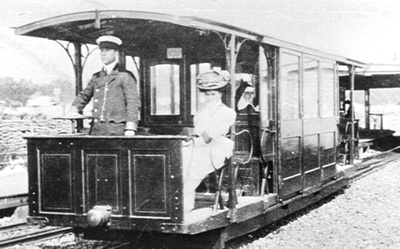
 Following the demise of the Daddy Long Legs, the Volks Electric Railway was extended further eastwards to Black Rock in 1901, thus allowing the creation of an enduring feature of the line, 'The Tunnel'. The Tunnel was a part of the original car sheds but converted to a through track so you were actually passing through the sheds! Heading eastward from the sheds at Paston Place, the line headed onto a steel viaduct at the Banjo Groyne then along wooden viaducts along the beach to a new 2 platform terminus at Black Rock. Volk intended on trying to extend to Rottendean, but there wasn't the funds to extend further. The extension to Black Rock required further cars, with Volk estimating that 7 cars would be required to operate the service so the railway built an additional cars numbered 6,7 and 8, giving an extra car for extra flexibility / cover for maintenance. 6,7 & 8 were all 40 seater Semi Open cars and had a similar look to cars 3 &4.
Following the demise of the Daddy Long Legs, the Volks Electric Railway was extended further eastwards to Black Rock in 1901, thus allowing the creation of an enduring feature of the line, 'The Tunnel'. The Tunnel was a part of the original car sheds but converted to a through track so you were actually passing through the sheds! Heading eastward from the sheds at Paston Place, the line headed onto a steel viaduct at the Banjo Groyne then along wooden viaducts along the beach to a new 2 platform terminus at Black Rock. Volk intended on trying to extend to Rottendean, but there wasn't the funds to extend further. The extension to Black Rock required further cars, with Volk estimating that 7 cars would be required to operate the service so the railway built an additional cars numbered 6,7 and 8, giving an extra car for extra flexibility / cover for maintenance. 6,7 & 8 were all 40 seater Semi Open cars and had a similar look to cars 3 &4.
In 1926, a further two cars built by the VER joined the fleet in the form of open cars 9 and 10, both of which had seating for 40 passengers.
Cut Backs
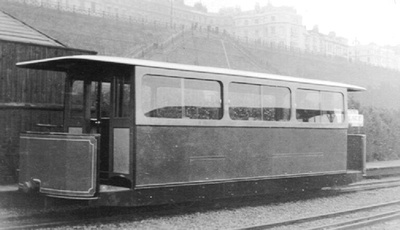
 The development of Maderia Drive in 1930, meant that the line was cut back at the west end from Palace Pier to opposite the Aquarium, with the station being renamed 'Aquarium' and being built with a 2 track layout. Volk decided at a winter car was needed and with the original Car 5 needing a rebuild, it was decided to scrap it and built a new one. In a complete change from the traditional wooden built cars, the new number 5, which had it's body built by G Kelsey Coachbuilders of Hove, had its bodywork completely fabricated from steel, with a wooden roof and wooden floor. No 5 had no outside passenger accomodation, all were seated indoors, in 2 long bench seats along the body sides, covered in blue leather and seating 24 passengers. The bodysides had 3 large sliding windows and the outside of the car was painted in a rather striking sky blue and primrose yellow colour scheme.
The development of Maderia Drive in 1930, meant that the line was cut back at the west end from Palace Pier to opposite the Aquarium, with the station being renamed 'Aquarium' and being built with a 2 track layout. Volk decided at a winter car was needed and with the original Car 5 needing a rebuild, it was decided to scrap it and built a new one. In a complete change from the traditional wooden built cars, the new number 5, which had it's body built by G Kelsey Coachbuilders of Hove, had its bodywork completely fabricated from steel, with a wooden roof and wooden floor. No 5 had no outside passenger accomodation, all were seated indoors, in 2 long bench seats along the body sides, covered in blue leather and seating 24 passengers. The bodysides had 3 large sliding windows and the outside of the car was painted in a rather striking sky blue and primrose yellow colour scheme.
The line was also cut back at the East end in 1937 to allow the building of a new open air swimming pool, however this gave the opportunity a modern Art Deco style replacement station, which was officially opened by Magnus Volk and the Deputy Mayor on 7th May 1937. Unfortunately, just 13 days after Black Rock station was opened, Magnus Volk died aged 85, with his son, Herman taking over.
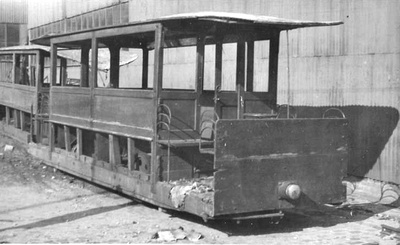
 Corporation take over
Corporation take over
In 1938, Brighton Corporation took control of the VER, initially leasing the line and operation back to Herman Volk, however, they assumed complete control on 1st April 1940. Unfortunately by this time Britain was at War and under the serious threat of Nazi invasion. By July 1940, the railway had closed for the duration, with the cars being transfered to Lewes Road tram / bus depot for storage and the stations at Aquarium and Black Rock being demolished. Later in the war, the depot was required for other purposes and the cars were moved out into secure open storage under the arches at Maderia Drive, with the outdoor storage causing irrepairable damage to cars 1, 2 and 5 which had to be scrapped.
Reopening
After the war, the line needed some serious work to get it operational again, Black Rock station was rebuilt again in the same art deco style as pre war, whilst a former tram shelter became the new station building at Aquarium. The full track was relaid as was the third rail. Replacement cars were sought for the scrapped cars and these came in the shape of 2 ex Southend Pier rail trailers, which seated 40 people and were converted to motor vehicles. They were fitted with ex milk float motors and became the fastest cars in the fleet!
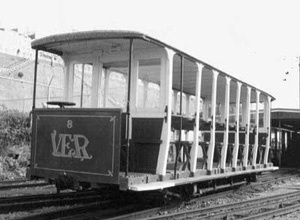
 A renumbering of the fleet occured to fill up the numbers left vacant by the scrapped cars with no 10 becoming no 1, no 9 becoming no 2 and no 8 becoming no 5 with the ex Southend cars becoming 8 & 9.
A renumbering of the fleet occured to fill up the numbers left vacant by the scrapped cars with no 10 becoming no 1, no 9 becoming no 2 and no 8 becoming no 5 with the ex Southend cars becoming 8 & 9.
The line reopened on 15th May 1948 and from Winter 1954 became seasonal only.
In 1964, a successful experiment with the coupling of 2 cars together was successful and all cars were converted to allow them to be coupled, meaning less staff and less individual cars could be used, ultimately saving money and allowing for track rationalisation at both termini with only one platform and track required.
Moving on towards the 1990s and the 1948 built station at Black Rock was demolished and a new station was incorporated into the building of a new pump house built next to the station for a storm drain project.
New Millennium
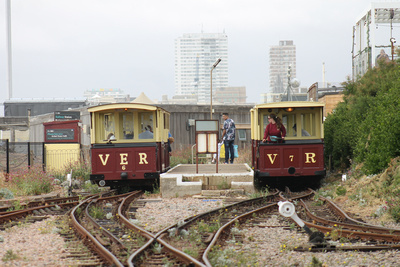
 Into the 2000s and the ex Southend cars were withdrawn as surplus and moved on with no 8 going back to Southend and being displayed in a glass box at the pier museum and no 9 going to the South Downs Heritage Centre. Cars 1, 2 and 5 then reverted back to their pre 1948 numbers of 10, 9 and 8.
Into the 2000s and the ex Southend cars were withdrawn as surplus and moved on with no 8 going back to Southend and being displayed in a glass box at the pier museum and no 9 going to the South Downs Heritage Centre. Cars 1, 2 and 5 then reverted back to their pre 1948 numbers of 10, 9 and 8.
After receiving Heritage Lottery funding in 2015, work was started on a major upgrade of the facilities on the line, which was badly needed as the car sheds had been condemned. The carsheds were completely flattened and rebuilt, with the Tunnel being retained through the car shed! Meanwhile the station building at Aquarium was also demolished and rebuilt, complete with a small visitor centre, ticket office and takeaway cafe built in. The car fleet also received some work with major restoration / rebuilt works being carried out on cars 4, 6 and 10. With car 3 also in the midst of a rebuild, the future of the VER is looking good!
Fleet List
|
Original Fleet Number |
Fleet Number (1948-2000) |
Current Fleet Number |
Car Type |
Year Built |
Seating Capacity |
Built By |
Current Status |
Notes |
Photo |
|
1 (I) |
N/A |
N/A |
Open |
1883 |
10 |
William Pollard |
scrapped |
Original car from the original demonstration line, could not be regauged from 2ft - 2ft 8 1/2 inches, scrapped 1884 |
|
|
1(II) |
N/A |
N/A |
Semi-Open |
1884 |
30 |
Unknown |
scrapped |
suffered the effects of outside storage for a long period during wartime, was too far gone for repair and scrapped in 1948 |
|
|
2 |
N/A |
N/A |
Semi-Open |
1885 |
30 |
Unknown |
scrapped |
suffered the effects of outside storage for a long period during wartime, was too far gone for repair and scrapped in 1948 |
|
|
3 |
3 |
3 |
Semi-Open |
1892 |
40 |
VER |
undergoing restoration |
Currently stripped awaiting restoration |
|
|
4 |
4 |
4 |
Semi-Open |
1892 |
40 |
VER |
in service |
received a major restoration between 2016-2018 |
|
|
5 (I) |
N/A |
N/A |
Semi-Open |
1896 |
30 |
VER |
scrapped |
Was in need of a major rebuild in late 1920s, was scrapped instead and replaced by 2nd no 5 |
|
|
5 (II) |
N/A |
N/A |
Closed |
1930 |
24 |
G Kelsey / VER |
scrapped |
Winter car, only car in fleet to have fully enclosed passenger saloons. Suffered the effects of outside storage for a long period during wartime, was too far gone for repair and scrapped in 1948 |
|
|
6 |
6 |
6 |
Semi-Open |
1901 |
40 |
VER |
in servce |
Received a major restoration 2016-2018, works as a pair with Car 10 |
|
|
7 |
7 |
7 |
Semi-Open |
1901 |
40 |
VER |
in service |
Works as a pair with car 8 |
|
|
8 (I) |
5 |
8 |
Semi-Open |
1901 |
40 |
VER |
in service |
Was numbered 5 between 1948 and 2000, works as a pair with car 7 |
|
|
8 (II) |
8 |
N/A |
Open |
1898 |
40 |
Falcon Works |
preserved |
Operational on VER from 1948 - late 1990s, now a static exhibit at Southend Pier Tramway |
|
|
9 (I) |
2 |
9 |
Open |
1926 |
40 |
VER |
in service |
Was numbered 2 between 1948 and 2000, works as a single car only |
|
|
9 (II) |
9 |
N/A |
Open |
1898 |
40 |
Falcon Works |
preserved |
Operational on VER from 1948 - late 1990s, now a static exhibit at South Downs Heritage Centre |
|
|
10 |
1 |
10 |
Open |
1926 |
40 |
VER |
in service |
Was numbered 1 between 1948 and 2000, works as a pair with car 6 |
.
Trip Report
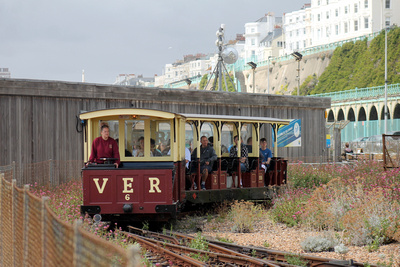
 I visited the VER on 25th July 2022 whilst on a daytrip to Brighton. Having only intended to visit for a very short time, I actually ended up spending longer than I expected on the railway (about 3 hours!).
I visited the VER on 25th July 2022 whilst on a daytrip to Brighton. Having only intended to visit for a very short time, I actually ended up spending longer than I expected on the railway (about 3 hours!).
Having never been in Brighton before, I decided to catch the City Sightseeing bus round to get my bearings, it was an interesting experience, especially losing my baseball cap, which blew off on the top deck and was squashed by a passing car!
I arrived at the Aquarium station, which is a couple of minutes walk from the Palace Pier and the City Sightseeing bus stop and bought my ticket then had a look round the visitor centre at the interesting displays and artifacts from the history of the line while I waited for the train to arrive. I didn't have long to wait as the trains run every 15 minutes as 1901 built Semi Open Cars 8 + 7 soon arrived and I boarded the open section of car 8, which would be the rear portion of the train for the mile long journey to Black Rock. We soon departed at a leisurely pace heading to Halfway, where we would await the arrival of the other train in service, made up of 1926 built open car 10 and 1901 semi open car 6 to allow the drivers to swap tokens for each stretch of single line. We continued our journey, passing through the tunnel, where car 4 and some permanent way vehicles were visible on the right hand side of the shed. All too soon we reached the terminus at Black Rock, where we all had to leave the train and reboard it although the driver was kind enough to let me take some photos of the train before I left the platform.
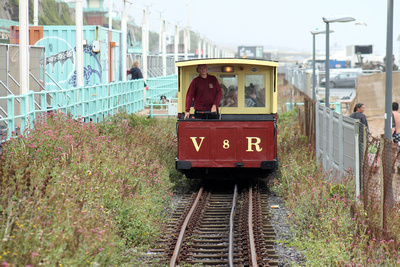
 I then joined the queue to reboard and this time I sat in the open section of car 7. On arrival at Halfway, I got off to take some photographs of the trains before heading to the workshop gallery to view the depot. Unfortunately the viewing gallery was closed, however I managed to photograph 1926 built Open Car 9 and a pw trailer, which were stabled in the left hand side of the depot from the station platform. Also out on the lineside at Halfway were some old wheels on axles and an old wooden underframe, which I assume was from Car 3 as it is currently undergoing an overhaul.
I then joined the queue to reboard and this time I sat in the open section of car 7. On arrival at Halfway, I got off to take some photographs of the trains before heading to the workshop gallery to view the depot. Unfortunately the viewing gallery was closed, however I managed to photograph 1926 built Open Car 9 and a pw trailer, which were stabled in the left hand side of the depot from the station platform. Also out on the lineside at Halfway were some old wheels on axles and an old wooden underframe, which I assume was from Car 3 as it is currently undergoing an overhaul.
After taking some more photographs from different locations around Halfway station, I caught Open Car 10+Semi Open Car 6 back to Aquarium, and I decided to take some more photos around that area, when the heavens opened and there was a heavy shower! After getting a few photographs, I made my way back into Brighton to catch the tour bus.
I'd like to thank the Volk's Electric Railway Association for allowing me to use some of their archive photographs in this post. My photos from the trip can be found at: https://scottishtrains.zenfolio.com/p588123192
I would definatley recommend a visit, the price of £5.60 for adults and £3.50 return for children is worth the money, the cars are all well kept and the staff are extremely friendly and helpful and will answer any questions that you have! To find out more about the Volk's Electric Railway (VER) and the Volk's Electric Railway Association (VERA), please visit their websites: https://volksrailway.org.uk/ VER: VERA: http://volkselectricrailway.co.uk/
